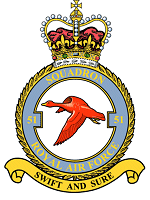
The Avro Vulcan is a jet-powered, tailless, delta-wing, high-altitude, strategic bomber, which was operated by the Royal Air Force (RAF) from 1956 until 1984. Aircraft manufacturer A.V. Roe and Company (Avro) designed the Vulcan in response to Specification B.35/46. Of the three V bombers produced, the Vulcan was considered the most technically advanced, hence the riskiest option. Several reduced-scale aircraft, designated Avro 707s, were produced to test and refine the delta-wing design principles.

Avro was a British aircraft manufacturer. Its designs include the Avro 504, used as a trainer in the First World War, the Avro Lancaster, one of the pre-eminent bombers of the Second World War, and the delta wing Avro Vulcan, a stalwart of the Cold War.

The Hawker Siddeley HS 748 is a medium-sized turboprop airliner originally designed and initially produced by the British aircraft manufacturer Avro. It was the last aircraft to be developed by Avro prior to its absorption into Hawker Siddeley.

The Rolls-Royce Olympus was the world's second two-spool axial-flow turbojet aircraft engine design, first run in May 1950 and preceded only by the Pratt & Whitney J57, first-run in January 1950. It is best known as the powerplant of the Avro Vulcan and later models in the Concorde SST.

Number 51 Squadron is a squadron of the Royal Air Force. Since 2014 it has operated the Boeing RC-135W Airseeker R.1, more commonly referred to as the Rivet Joint, from RAF Waddington, Lincolnshire.

The Hawker Siddeley HS 780 Andover is a twin-engined turboprop military transport aircraft produced by Hawker Siddeley for the Royal Air Force (RAF), developed from the Avro-designed HS 748 airliner. The Andover was named after the Avro Andover, a biplane transport used by the RAF for medical evacuation between the first and second world wars; and RAF Andover, where some of its trials were carried out. The Andover had a kneeling landing gear to make ramp loading easier.

The Hawker Tomtit is a British training biplane from the late 1920s.

Air Chief Marshal Sir Harry Broadhurst,, commonly known as Broady, was a senior Royal Air Force commander and flying ace of the Second World War.

Alfred William Bedford OBE AFC FRAeS was a British test pilot and pioneered the development of V/STOL aircraft.
Squadron Leader Hedley George "Hazel" Hazelden was a British test pilot.
Wing Commander Roland "Roly" John Falk OBE AFC* was a British test pilot noted for being at the controls on the maiden flight of the British V bomber, the Avro Vulcan. Falk typically flew dressed in pin stripe suit and tie.

Captain Hubert Standford Broad, MBE, AFC (1897–1975) was a British First World War aviator and noted test pilot.

Frederick Phillips Raynham (1893–1954) was a British pilot from the early days of aviation, gaining his aviator's certificate in 1911. He test-flew Avro, Martinsyde, Sopwith and Hawker aircraft before and after World War I. He later formed the Aircraft Survey Co. and the Indian Air Survey and Transport Co., flying in India and Burma.
John William Fozard, was a British aeronautical engineer who helped to design the Hawker Siddeley Harrier.
Stuart Duncan Davies CBE FREng FRAeS was a British aerospace engineer who was in charge of the design of the Avro Vulcan. He was also responsible for converting the unsuccessful two-engined Avro Manchester into the four-engined Avro Lancaster.
The RAF College of Air Warfare is a former Royal Air Force flying training unit operational between 1962 and 1974. The unit traces its history back to 1942 as the Empire Central Flying School.
Duncan Menzies Soutar Simpson was a Scottish pilot, and the former chief test pilot of Hawker Siddeley in the 1970s. He flew the first production Harrier aircraft in December 1967, and the first two-seat Harrier in April 1969.

Air Vice Marshal Harjinder Singh, PVSM, MBE was an Air Officer in the Indian Air Force. He was one of the earliest to join the newly created Indian Air Force (IAF) in 1933 in the lowest rank of 'Hawai sepoy'. In a career spanning over three decades and two wars, he rose from the lowest enlisted rank to the then second-highest rank in the Indian Air Force. Hailed as technical wizard and innovator, he is considered a legend of the IAF.
David Pettit Davies was a British test pilot who was chief test pilot for the United Kingdom Civil Aviation Authority for 33 years. He was known as "the test pilots' test pilot".













